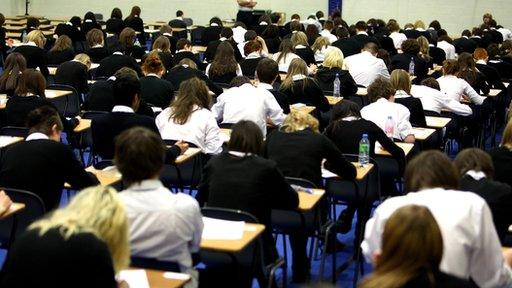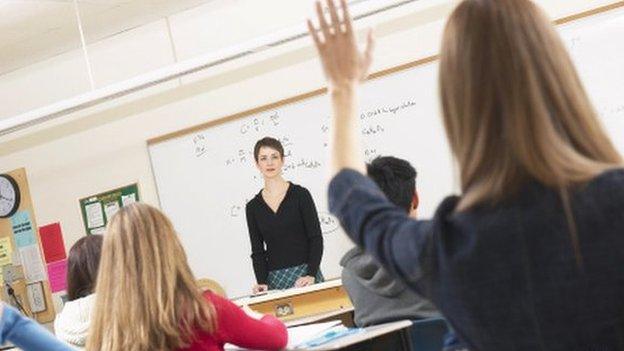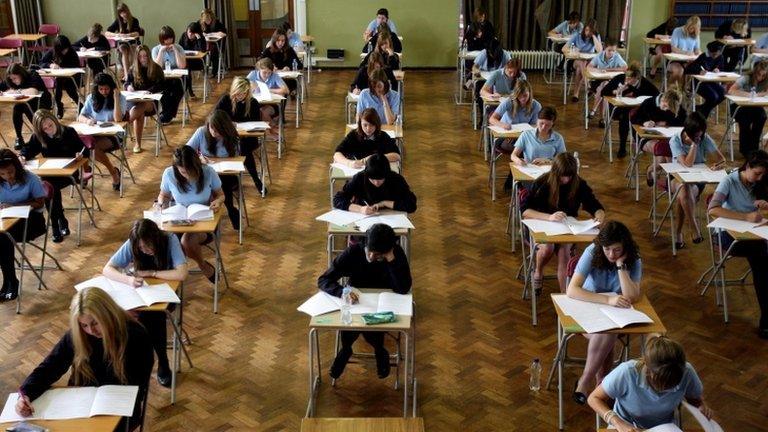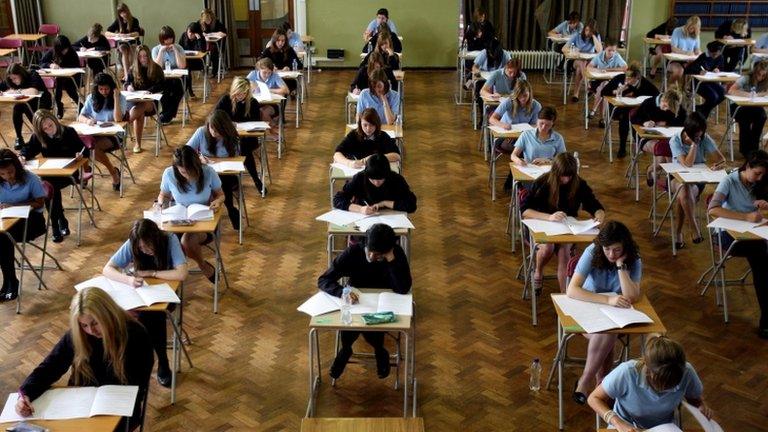Numeracy level falls across Scottish schools, survey shows
- Published

The Scottish government has pledged an extra £1m to improve levels of numeracy across schools
The number of primary school pupils doing well in maths has dropped, according to official figures.
The figures were revealed in a Scottish government survey of numeracy in Scottish schools.
Data showed the percentage of P4 pupils performing well or very well dropped from 76% in 2011 to 69% last year.
The government said it will make an extra £1m available to fund numeracy hubs, to help share good practice.
This is the second comparable National Numeracy Survey.
A total of 10,561 pupils across Scotland in P4, P7 and the second year of secondary school took part.
The proportion of P7 pupils doing well or very well fell from 72% in 2011 to 66% in 2013.
Falling achievement
Because this is only the second set of figures, statisticians would caution against drawing a trend. However the drop in the numbers doing well or very well is still likely to raise some concern.
The report's figures, external also draw attention to the continuing challenge of falling achievement once pupils move to secondary school. In both surveys 42% of S2 pupils were performing well or very well.
The survey also suggested a significant drop in the number of children from the most deprived background in P4 performing well or or very well - down from 70% in 2011 to 61% in 2013.
Minister for Learning Dr Alasdair Allan announced the extra money for numeracy hubs on a visit to Stobhill Primary in Gorebridge in Midlothian.
The funding for numeracy hubs will be increased by £1.02m over three years to a total of £1.2m, to allow creation of additional hubs and the expansion of the current six.
Stobhill Primary is part of the Midlothian and East Lothian Numeracy Academy, which brings together a number of schools that are using a new approach to teaching maths; training teachers as champions who can share best practice in their schools.
The numeracy hubs work in a variety of ways to train teachers in new techniques around maths and to share best practice between local authorities.
New approach
Dr Allan explained: "Expanding and accelerating the development of numeracy hubs is an effective way of raising attainment in maths and I am confident that today's announcement will lead to further improvements.
"A range of measures of pupils' attainment in numeracy, such as the latest PISA (Programme for International Student Assessment) figures and evidence from recent school inspections, are positive.
"The picture that emerges in these figures is one of very few pupils at P4 or P7 not working within the expected level, yet there is a clear issue by S2.
"We know from other figures that in the later stages of secondary the position improves, with a jump in recent years in the percentage of school pupils leaving with Higher Maths - up from 19% in 2007-08 to 24% in 2011-12."
He added: "We are therefore working across government and with a range of partners to address this issue and give every child in Scotland the best start in life."
Iain Ellis, chairman of the National Parent Forum of Scotland (NPFS) said: "We recognise the crucial importance of numeracy as a skill that opens many doors for a child's future. The role of parents is vital to improving children's skills in this area from an early age.
"The NPFS will work with government and other partners to ensure that parents get the information and support they need to help develop their child's numeracy skills."
He added: "We believe that more can be done if we all work together. We welcome the commitment of the Scottish government to putting in further support for teachers, parents and children."
Scottish Labour MSP Kezia Dugdale said the figures were "a wake-up call for the Scottish government".
'Significant drop'
"They show a marked drop in the proportion of children who are performing well or very well in numeracy at primary school, and no improvement at S2 level," she said.
"They also reinforce what we already know: pupils who come from the poorest households are lagging well behind those who come from wealthier backgrounds."
Scottish Conservative education spokeswoman Mary Scanlon said the statistics were "further proof that all is not well in Scottish education when it comes to the crucial matter of improving literacy and numeracy.
"The fact there remains a significant drop in competency between primary and secondary school is a real worry and it is also the reason for the large attainment gap between different groups of pupils.
"Time after time, teachers and parents are battling against a system which nurtures mediocrity rather than excellence."
Larry Flanagan, general secretary of the EIS trade union, said the figures highlighted the need for change in the education system.
He said: "Although the drop is relatively small and there are a number of potential mitigating factors, it does serve to underline the point which the EIS has been making, that there remains an ongoing need for additional support to embed Curriculum for Excellence in the primary sector.
"The current focus on the new qualifications has often led to the mistaken believe that the process is complete in primaries when clearly it is not. It's inequitable, for example, that secondary schools have been granted a further additional in-service day but primaries have been denied the same access to professional development opportunities."
He added: "One area, for example, which clearly needs to be looked at, is the transition from primary to secondary, and that needs both sectors to work together. We would call on the Scottish government to treat primary schools fairly and to provide the additional in-service time required."
- Published29 April 2014

- Published16 April 2014

- Published15 April 2014

- Published6 January 2014
